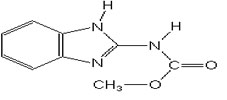|
Carbendazim
|
|
Chemical name: |
Carbendazim |
|
CAS No.: |
10605-21-7
|
|
Empirical formula: |
C9H9N3O2
|
|
Structural formula: |
 |
|
Molecular mass: |
191.18 |
|
Basic chemical and physical data: |
White powder. Sublimate at 216 – 217℃. Melting point 307 – 312℃ (decompose). Density 1.45±0.05g/cm3 (20℃). Vapor pressure 1.33μPa (20℃). Solubility in water (24℃): 29mg/L (pH 4), 8mg/L (pH 7), 7mg/L (pH 8); 0.5mg/L in hexane, 36mg/l in benzene, 300mg/L in ethanol and acetone, 68mg/L in dichloromethane, 135mg/L in ethyl acetate. It is stable in acidic and basic conditions, and it is also stable to sunlight. |
|
Usage: |
Carbendazim is a systemic benzimidazole fungicide that plays a very important role in plant disease control. Carbendazim is used to control a broad range of diseases on arable crops (cereals, oilseed rape), fruits, vegetables and ornamentals. It is also used in post-harvest food storage, and as a seed pre-planting treatment. Carbendazim works by inhibiting the development of fungi probably by interfering with spindle formation at mitosis (cell division). |
|
Toxicity: |
Carbendazim is classified by the World Health Organisation (WHO) as ‘unlikely to present hazard in normal use’. The acute oral LD50 for rats is greater than15000 mg/kg, greater than 8000 mg/kg for dog |
|
Storage: |
Carbendazime shall be stored in a cool, dry and well ventilated place. It should not be stored or transported along with foods. |
|
Package: |
25kg woven bag, or according to the customer’s requirements. |
|
Attention: |
|
|
Formulation: |
50%SC;50%WP;75%WDG |
|
|
|
|
Specification of technical: |
|
|
Appearance: white powder
Content of A.I.: 98.0% min.
Moisture: 0.5% max.
OPDA: 0.3% max.
Acidity: 0.5% max.
Fineness: 98% min. passing through 325 mesh sieve
White: 85 min.
DAP+HAP: 3.5ppm max. |